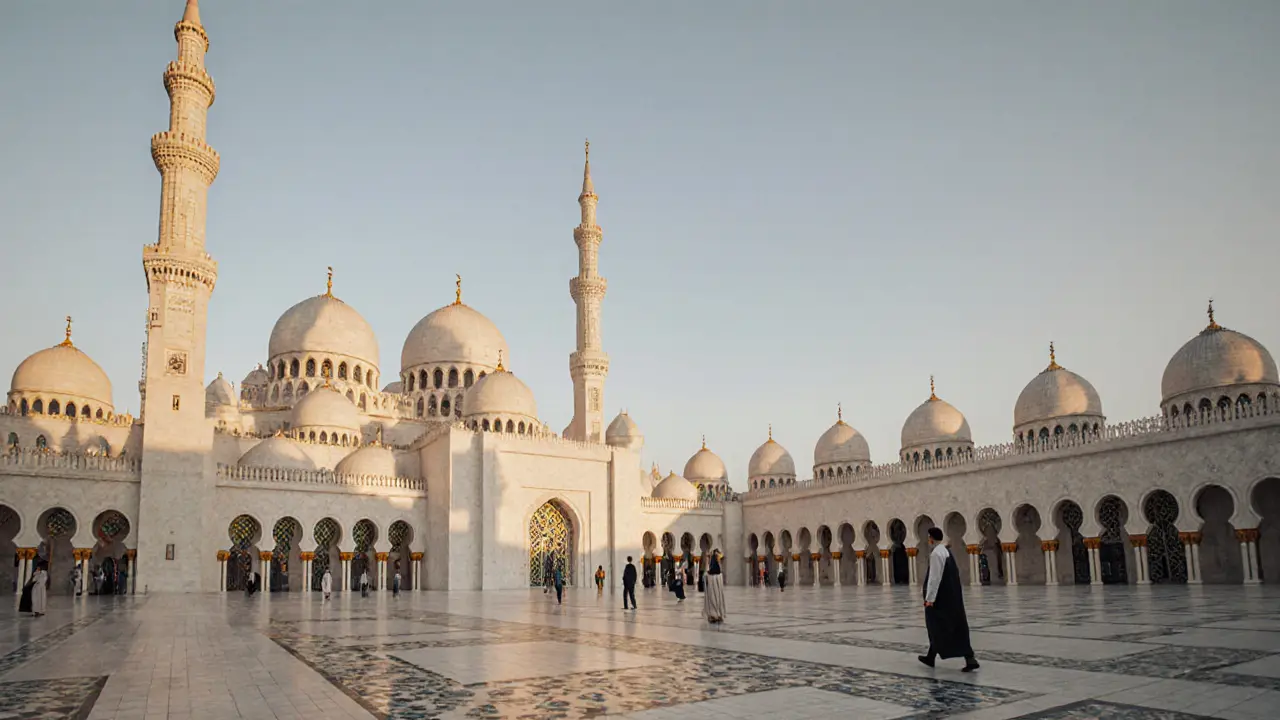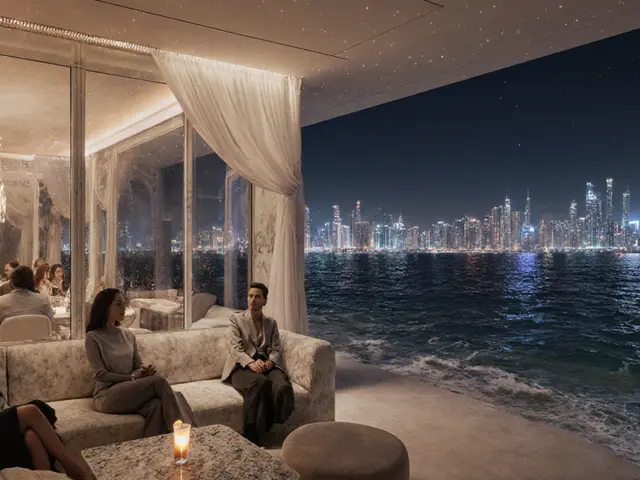
Walking up to the Jumeirah Mosque, you don’t just see a building-you feel a presence. The white stone glows under the Dubai sun, its twin minarets rising like prayers carved into the sky. Unlike the glass towers and neon signs that define much of the city, this mosque doesn’t shout. It invites. And if you’ve ever wondered what makes this one of the most visited religious sites in the UAE, it’s not just its beauty. It’s the quiet, living culture woven into every arch, every tile, every moment of stillness inside.
A Mosque Built for People, Not Just Prayer
The Jumeirah Mosque wasn’t designed to be a hidden sanctuary. It was built in 1979 to serve the growing Muslim community in Dubai, but its architects had another goal: to open Islam’s heart to the world. Most mosques in the region are closed to non-Muslims. Jumeirah is one of the few that welcomes visitors through guided tours. That decision didn’t come from tourism boards or marketing teams. It came from a simple belief-that understanding begins with seeing.Today, over 100,000 people a year walk through its gates. Not as tourists snapping photos, but as learners. They sit on the carpets, listen to explanations of the calligraphy, touch the hand-carved marble, and ask questions. Children point at the geometric patterns. Grandparents trace the same designs they remember from their own childhood mosques. It’s not a museum. It’s a living classroom.
The Architecture That Speaks Without Words
The mosque’s design draws from Fatimid and Mamluk styles-centuries-old traditions from Egypt and Syria. But it’s not a copy. It’s a reimagining. The dome, 27 meters high, is made of white limestone and holds 22,000 hand-cut tiles. Each one was glazed and fired separately. No two are exactly alike. The minarets, each 36 meters tall, were built to echo the call to prayer across Jumeirah’s coastal neighborhood, not to dominate the skyline.Inside, the prayer hall can hold over 1,200 people. The floor is covered in handwoven Persian carpets, imported from Iran. The walls are lined with Quranic verses in Kufic script, etched into plaster and painted in gold leaf. The light filters through stained-glass windows, casting patterns that shift with the sun. At noon, a stripe of amber light moves slowly across the floor like a clock made of sunlight.
What you won’t see? Any images of people or animals. Islamic tradition avoids depicting living forms in sacred spaces. Instead, the art speaks through geometry-endless stars, interlocking polygons, flowing arabesques. These aren’t just decorations. They’re reminders: the universe is ordered, infinite, and beyond full human comprehension.

More Than a Place of Worship
The mosque isn’t just open for prayer. It’s open for conversation. The Sheikh Mohammed Centre for Cultural Understanding (SMCCU) runs daily tours, free of charge, led by Emirati guides who answer questions about daily life, fasting, prayer, and even why women wear headscarves. These aren’t scripted performances. They’re real conversations. One guide told me she once had a visitor from Norway ask if Muslims in Dubai still ride camels to work. She laughed, then showed him a photo of her son in a school uniform, holding a tablet.There’s no pressure to convert. No pamphlets pushed. Just space. Space to sit. Space to listen. Space to be curious without judgment. In a city where billions are spent on spectacle, this is quiet radicalism: openness without agenda.
Cultural Bridge in a Global City
Dubai is home to over 200 nationalities. Most mosques here serve their own communities-Pakistani, Indonesian, Egyptian, Somali. But Jumeirah Mosque was built to be a bridge. It hosts interfaith events, school groups, diplomats, and even visiting clergy from Christian and Jewish communities. In 2023, over 300 students from a local international school spent a morning learning about Ramadan. One 12-year-old wrote in her journal: “I thought mosques were just for prayers. Now I know they’re for people.”The mosque also plays a role in preserving Emirati heritage. Traditional crafts are taught here-calligraphy, lantern-making, textile weaving. Elderly artisans come in to teach young volunteers. These aren’t performances for tourists. They’re acts of cultural continuity. The same hands that once stitched prayer rugs for their grandparents now teach teenagers how to do it with modern tools.

What You’ll Experience When You Visit
If you plan to go, here’s what to expect:- Visit between 9 a.m. and 4 p.m., Sunday through Thursday. The mosque closes on Fridays for prayer.
- Dress modestly: shoulders and knees covered. Scarves are provided if you forget.
- Shoes are removed before entering the prayer hall. There are storage areas for bags and shoes.
- Photography is allowed outside and in designated areas inside-but never during prayer times.
- Tours last about an hour and are offered every hour. No booking needed for individuals.
You won’t find gift shops selling “I ❤️ Dubai” souvenirs. There’s a small room with books on Islam in multiple languages, and a quiet café serving Arabic coffee and dates. That’s it. No loudspeakers. No crowds. Just calm.
Why It Matters Now More Than Ever
In a world where religion is often framed as division, Jumeirah Mosque stands as proof that it can also be connection. It doesn’t hide its faith. It shares it. And in doing so, it changes how people see Islam-not as an abstract idea, but as a living, breathing culture with deep roots and open arms.It’s not the biggest mosque in Dubai. It’s not the oldest. But it might be the most human. You don’t leave feeling like you’ve seen a landmark. You leave feeling like you’ve met a neighbor.
Can non-Muslims enter Jumeirah Mosque?
Yes. Jumeirah Mosque is one of the few mosques in Dubai open to non-Muslim visitors. Guided tours are offered daily from 9 a.m. to 4 p.m., Sunday through Thursday. Visitors must dress modestly, and shoes are removed before entering the prayer area. No conversion or religious participation is required.
Is there a fee to visit Jumeirah Mosque?
No. Tours are completely free. The mosque is maintained by the Sheikh Mohammed Centre for Cultural Understanding (SMCCU), a nonprofit organization that funds its programs through donations and educational partnerships. Donations are welcome but never required.
What should I wear to visit the mosque?
Modest clothing is required. Women should cover their shoulders and knees, and wear a headscarf. Men should wear long pants and shirts that cover the arms. Scarves and robes are provided at the entrance if you arrive in inappropriate clothing. Flip-flops and shorts are not permitted.
Can I pray at Jumeirah Mosque if I’m not Muslim?
No. The prayer halls are reserved for Muslims only during prayer times. Non-Muslim visitors are welcome to observe from designated areas during tours, but participation in prayer is not permitted. Respect for the sanctity of worship is expected.
When is the best time to visit Jumeirah Mosque?
The best time is early morning or late afternoon, when the light hits the white stone beautifully and the crowds are smaller. Tours run every hour from 9 a.m. to 4 p.m., Sunday through Thursday. Avoid Friday afternoons-the mosque closes for congregational prayers and reopens for tours on Saturday.
Visiting Jumeirah Mosque isn’t about checking a box on a Dubai itinerary. It’s about stepping into a space where faith, art, and hospitality meet without noise or pretense. In a city built on speed and scale, it reminds you that some things are meant to be felt, not rushed.



